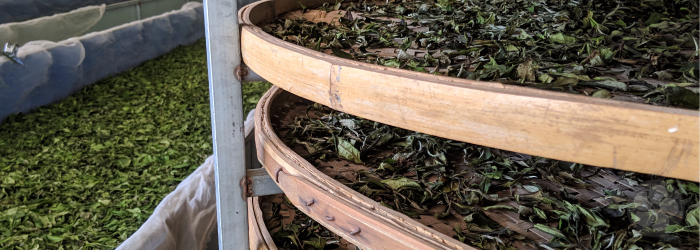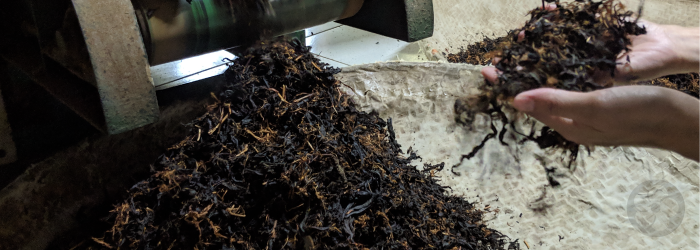How Oxidation Changes Tea Flavor

Though many variables during the process of making tea can affect the final flavor of the brew, oxidation is arguably the most impactful step. Beginning when tea leaves are plucked, oxidation happens as cell walls are broken, exposing enzymes within the leaf to oxygen in the air. The leaf begins to brown, and continues until it is heated, which denatures the active enzymes and preserves the desired level of oxidation in the finished tea.
Learn about the difference between oxidation and fermentation >>
The main categories of tea that we know today are defined primarily by their levels of oxidation. Green teas are roasted shortly after harvest to keep oxidation minimal. The various styles of oolong tea cover the middle range of the spectrum, and black teas are called ‘fully’ oxidized at more than 80% browned. If several leaves were plucked from a single plant and oxidized to different levels, they would be sorted into different categories, despite being of the same variety, provenance, or even picked on the same day.
Find out more about tea categories and their oxidation levels in this video:
Clearly, this all-important stage of processing must have some major impact on flavor. But the influence of oxidation is hard to isolate, since crafting methods are usually specific to each traditional region. If we were to taste the hypothetical teas above, plucked from the same tea bush on the same day but processed in different ways, what range would we find in flavor? What molecular changes take place during oxidation that have such a profound effect on our palate? And what makes some varieties and harvests more suited for oxidation than others?
Learn more about oxidation and the other five steps of tea processing >>
Factors in Flavor
Much of what makes up the aroma and flavor of each cup of tea are volatile substances in miniscule amounts and endless combinations. These are often responsible for floral aromas and fruity flavors, but are difficult to measure and quantify since they are so variable. Instead, most research focuses on the more tangible effects of non-volatile substances that influence flavor in tea leaves, like amino acids, carbohydrates, and polyphenols.
Amino Acids
A large array of amino acids exist in tea, including L-theanine, which works in concert with caffeine to produce the characteristic ‘relaxed alertness’ tea is known for. In terms of flavor, some amino acids contribute to the sweet finish of a tea, while others add umami, or ‘brothiness’. During growth, amino acids are converted to polyphenols like catechins under the influence of sunlight, so teas that are exposed to less sun retain higher levels of these desirable flavors (1). In addition, the fuzzy down that appears on young spring buds of some varieties has been shown to be exceptionally high in amino acids and lend extra umami flavor (2).
Learn more about the beneficial properties of L-theanine >>
Carbohydrates
Produced by the tea plant as a form of energy, carbohydrates are created in mature leaves, sent to the roots for storage during dormant winter months, and retrieved to power the growth of new buds in spring. While they help to make this new growth naturally sweet, the higher levels found in mature leaves (1) are balanced by higher levels of bitter polyphenols.
After the leaves are harvested, carbohydrates also help to power the process of oxidation (3). The roasting which halts oxidation also lessens the quantity of bitter catechins and transforms carbohydrates into soluble sugars, bringing forth sweetness from mature leaves (4).
Polyphenols
There are many different types of polyphenols found naturally in tea, but for now we’ll focus on the best studied. In green teas, these are catechins. Though they are credited with many of tea’s health benefits, catechins also taste bitter and astringent (5). Green tea leaves picked early in the harvest season have moderate levels of catechins, balanced by a lot of amino acids for a taste that is mellow and rich, while leaves picked later in spring or summer have high levels of catechins, along with fewer amino acids, resulting in flavor that is more bitter and astringent (6).
Discover the impact that harvest season has on tea flavor >>
The Process of Oxidation
During oxidation, the catechins present in freshly plucked leaves are converted to new types of polyphenols - primarily theaflavins and thearubigins. These compounds contribute to the dark color of oxidized teas, but they also contribute to flavor. While catechins are often identified as bitter, theaflavins and thearubigins contain astringency without bitterness. Theaflavins, in particular, are also associated with ‘richness’ of flavor (7).
Learn how to taste richness and complex flavors with Alice in this video:
It is estimated that about 10% of catechins in a leaf become theaflavins, while nearly 90% become thearubigins. Higher quantities of catechins in the fresh leaf will result in higher levels of theaflavins, and thus, richer flavor. This is important, as amino acids degrade during oxidation, causing darker teas to lose the umami characteristics found in high quality green teas (8).
Find out more about how we define 'rich' flavor notes >>
Comparing Oxidation Levels
One study, performed with the classic oolong variety Tieguanyin, compared the same tea with various levels of oxidation. Flavor analysis of six different attributes found that low levels of oxidation increased natural sweetness, floral aromas, and ‘green fruity’ flavor. With further oxidation, lower levels of catechins and higher levels of theaflavins caused an increase in astringency, but a decrease in bitterness. (9)
These findings are borne out by our own experience with teas like our unusual Eastern Beauty, a black tea made from an oolong cultivar, or our New Craft white tea, which contains white tea leaves oxidized more like an oolong. While both of these teas lack some of the umami body of their traditionally crafted versions, they make up for it in rich flavor with more overt fruit tones.
Ultimately, oxidation doesn’t determine the quality of a tea, but it does play a big part in forming flavor characteristics. Understanding how flavor changes during this process can help in understanding our own palates, and give meaning and voice to our personal preferences. Most of all, it can give us a greater appreciation for the endless complexity of tea, and the many ways a single leaf can be transformed before it ends up in our cup.
What flavor differences have you observed between oxidation levels? Let us know what you think in the comments below!
Sign up for our newsletter to get blog updates in your inbox!






Comments on this post (0)